Matthew S. Williams's Blog, page 42
July 30, 2014
Oscar Mike – Prologue
The king who is situated anywhere immediately on the circumference of the conqueror’s territory is termed the enemy. The king who is likewise situated close to the enemy, but separated from the conqueror only by the enemy, is termed the friend.
-Kautilya, Arthasastra: Book IV
The sound was like a gentle beating in his ears. An intermittent thrum that kept reverberating in the dark. His eyes went in and out of focus, watching as the hard, graceful wings looped endlessly in an unending dance. He blinked many times, his mind moving in and out of the darkness. And all the while, a strange sensation was building in the back of him, like a burning light that was slowly became brighter.
The thrum was getting stronger too, and it was soon interrupted by a high-pitched whine and a loud voice…
“On your feet!”
A deafening roar sounded and he has hit by something hard. His skin prickled at the feel of terrible heat, and he realized he was awash in it. His mind went dark again for a moment, then came back to the light as he felt a sharp sting against his face. When his eyes opened, they saw the face of a familiar-looking man, and heard the same voice calling to him again.
“Get up! Get up!”
He drew in breath and felt another sharp sting. His body had been shocked into wakefulness again, and all at once, the landscape became a very noisy, very ugly place.
“Get up! We gotta move, sir!”
The face pulled away and a hand descended onto his chest, pulling at his uniform. The next thing he knew, he was on his feet and being shoved from behind. Close by, he saw the burning wreck of what had once been the beating wings, the body of their evac chopper. He could barely stand, barely move his body. And yet somehow, he knew to turn his back to it and run.
“C’mon! We got to get to the treeline before another -“
Another high-pitched whine and another roar followed, bringing with it another burst of heat and another powerful wave. This one sent him low; and above, the sound of several more terrible whines were coming in. He closed his eyes and just kept running. Surely, these ones would miss him if he could just block them out. Or, one might find him, and turn the world black forever…
“Sir! Sir! Look at me!”
The voice was coming from beside him this time. Bellard looked to it and instantly recognized who it was. He quickly sat up, but several deep breaths were needed before he could speak.
“Marcel,” he said, wiping his face. He noted the generous amount of sweat there, despite how cold he felt. “What happened?”
“You were having a nightmare, sir,” said Marcel, offering him his canteen. “And you instructed me to wake you when we found the path again.”
Bellard drank deeply from the canteen, his mouth accepting the cool water gratefully. He noted the brackish taste, and the unmistakable tang of iodine tablets. When he was finished, he processed what the Corporal was telling him and quickly remembered.
“Ah, yes. How far is it?”
“About a klick or so up ahead. Tree cover’s good. And no sign of ghouls.”
“Good.” Bellard wiped his face again. He immediately became aware of the thick stubble on his face, his sweat-soaked hair and the state of his clothes. For some reason, this made him think of the rest of the crew, who were still sleeping behind him. Lying in the recesses of some tree roots, each of them had made a pillow from their backpacks and a blanket from their uniform tops. He lamented the idea of waking them again after what felt like such a restless sleep, but they had to keep moving.
Raising himself up on one knee and then planting his boot solidly on the ground, he got a sharp spasm of pain that went from his back to his toes. He tried to talk over the pain to avoid moaning too loudly.
“Gather the others. We need to get moving before nightfall.”
“Yes, sir.” Marcel hurried past and began rallying the rest. The sounds of groaning and muttering from them followed, a familiar sound after days of forced marching.
Getting up the rest of the way proved difficult for Bellard, as his legs proving to be weaker than he had given them credit for. His head was also noticeably heavy, and the ground seemed to spin a little when he tried to straighten up.
And then the pain in his back returned, firing in his lower back and running the length of his leg. It was much worse this time, and he almost fell over from the shock of it. Luckily, he caught himself on one knee; and when up again, he saw Marcel standing beside him. One hand was resting on his shoulder, the other firmly grasping at his weapon.
“Can you walk, sir?”
“Yes…” he uttered. “Pinched nerve. I’ll be okay.”
“You sure? Don’t want you losing the use of your legs there.”
Bellard sensed the gentle mockery in his tone. At another time, he might have laughed. But at the moment, he prayed It wouldn’t come to that.
“I’m fine,” he said with false confidence. He looked back at the others and promptly changed the subject. “How are they doing?”
Marcel’s smile faded. “They said they wanted to talk to you first.”
Bellard knew instantly what to expect, but nodded just the same. For days now, his colleagues had been griping about the same thing: what was the plan? What were they to do for supplies? And what did they hope to do about the morass they were in? He had become rather well practiced at addressing their concerns by now.
“Assemble your squad. We move together in five mikes.”
Marcel issued a salute and took off. Habits of the grunts, they saluted the rank and not the man. Even now, when Bellard and the others were little more than dead weight, they still trusted in the silver bars he carried on his shoulders to see them through to safety. He suspected they might feel differently if they had a chance to sit in on one of his conversations with his associates…
He hobbled over and sidled up to Penn. Taggart and Drake took a knee nearby and moaned unhappily. He noted the shaking in their hands and the pallor in their faces. It was worse than usual. Between fatigue and water discipline, they were beginning to fade. He anticipated a had conversation.
“Alright, what’s the problem now, specialists?”
Penn was the first to speak, and it was quite the effort for him to get all the words out without becoming winded. “What are we even doing here, Ted? What’s our end game?”
“We’ve been over this, George,” he replied. “We’re going to get to the high ground. We’re going to keep moving until we are above the tree line, and away from the ghouls and all the fighting.”
“Yeah, and then what?”
It was Drake asking this. Bellard paused for a second as he considered that question. In the past few days, no one had asked what they planned to do once they reached their destination.
“What do you mean?”
“What he means is,” Taggart interjected, “what are we supposed to do when we get up into the hills? It’s not like anyone’s waiting for us up there. We’re running out of food and water, and there’s no guarantee anyone’s going to be able to rescue us.”
“I know, Beth. But what choice do we have?” He motioned to the east. It only took a few seconds before the noise of the carnage that was still going on down there reached them. The sounds of small arms fire and the occasional din of something heavier exploding. He summarized it for them as best he could. “People in uniform are still killing each other, and the ghouls are likely to overrun all of them eventually. We can’t stay in the valley. We have to get higher.”
“But what’s waiting for us up there?” asked Penn. “Sun, exposure, and whole lot of fucking rocks?”
Bellard grumbled. “I repeat… what choice do we have? At least up there there’s the possibility of safety. The rest… we can deal with that once we get there.”
Taggart and Penn grumbled right back at him. Only Drake seemed to be able to maintain a modicum of tact at the moment.
“It just sounds like we’re trading one shot at certain death for another. And we haven’t even addressed the larger issue of what’s on its way.”
Bellard looked over his shoulder to see if Marcel or any other of the grunts were nearby. He spotted PFC Rickard, one of the riflemen from the 29th that had made it out with them. The rest were moving up ahead, stepping through the wall of foliage the lined their clearing and fanning out to watch for ghouls. Only Rickard was within earshot, and he was concerned that any mention of what they knew would elicit suspicion.
They had agreed some time ago that no mention was to be made of the “larger issue”. They were having a hard enough time maintaining their own morale. They did not need their escort falling to pieces and questioning the nature of what they were doing too. And without their equipment handy, there really was no way of telling how far off it really was.
He raised his hands to them for quiet. “Look, if what we learned before is true, then it is all the more important to get to somewhere secure. The high ground in this region is our best bet of that. There’s simply no other place we can go. Not unless we can find ourselves a chopper and fly the hell out of here.”
“In that case…” said Taggart. “We might want to discuss what will happen if we get spotted up there.”
“You mean… if an enemy spotter goes flying by?”
She nodded. Drake once again had his tactful two cents to offer. “If we’re talking about survival at all costs here, and the enemy actually prevails down there, then it might be best to raise the white flag if they see us.”
Bellard sighed and looked at his feet. All this talk was beginning to take its toll and he could feel his back beginning to cramp up again. And the thought of allowing for their capture by the enemy; somehow, that seemed to make him feel worse. But they were right. It was obvious to anyone who had been there that General Montag and his task force had been beaten. Their grip on the valley had been tenuous during that last day, and the counter-attack had left no doubt as to who was going to win.
That’s when the ghouls came, like a terrible wall of wild animals from the northern mountains. There was no telling how the Rebels would fare against that, but if they came through, they would be the only ones left in the region that could give Marcell and his colleagues food, shelter and aid. Besides, they had a right to know as well. Rebels or not, they didn’t deserve to be overrun.
“Yes… that might be the best course of action,” he conceded. “I just hope our escort there prove to be as understanding.”
The others emitted some chortled sounds that almost sounded like laughter. They all knew it wouldn’t be as easy as that. As hardened grunts, they would not simply lay down there arms because a bunch of specialists told them to. Whatever respect they held for Bellard’s rank would most likely disappear at that point. But that was another die and another crisis. And there was no telling Marcel and his friends would even make it that far. And if their ranks were thinned, perhaps they would need less in the way of convincing…
“Alright. We’ll deal with that when the time comes. In the meantime, let’s get moving. We need to get out this valley as soon as possible. Otherwise, we might find ourselves -“
A yell came from the other direction. Every head in their group spun around to look for the source. All they saw was Rickard crouching low with his weapon raised. Slowly, he moved forward, trying to catch sight of his companions in the thick brush.
“Corporal?” he whispered loudly. “Manning? Paige? Sound off!”
Bellard and the others were crouched low too. In spite of the shooting pains that were going through his knees and back, he sat low, breathing quietly and straining to hear.
“Corporal? Marcel? What happened?” Rickard said louder. Weapon raised, he took a more few steps and pierced the foliage wall. His last step coincided with the tip of an arrowhead sticking out through the back of his neck, the metallic point slick with blood. He emitted a short, choking noise, and then fell.
Taggart yelled out. “Private!”
Penn quickly wrapped his hand around her mouth and dove to the ground. “Down, everyone!”
Bellard and Drake followed. All together, they lay in the dirt now, hugging the moist earth and waiting for something to happen. It was several seconds before they heard anything; and surprisingly, it wasn’t the sound of an arrow zipping overhead.
It was rustling, and it was coming from the bushes. Worst yet, it was coming from all around them, and getting closer. Then, it was the sound of boots coming to rest in the dirt, and someone clearing their throat…
“On your feet,” said a male voice. Slowly, Bellard raised his hands and painfully got on his knees. He hoped his position would be seen as a sign of cooperation, because at the moment it was the best he could do.
“Rest of you too,” the man said. Around him, the others began to oblige and got up with their hands raised.
Bellard slowly looked over and caught sight of the man’s face. The head was largely obscured by a hood, and the eyes covered by a set of goggles. But he did notice the thick stubble and the black paint rubbed across his cheeks.
He looked to the man’s companions next, all of whom carried hunting bows or machetes. Each wore what looked like a piece of green canvas that had been altered to carry a hood. Whoever they were, they weren’t part of the 200th.
“You armed?” the man asked.
Bellard looked at the others and then replied. As ranking officer, it seemed to fall on him to negotiate their surrender. Or whatever this was.
“No. We left our weapons behind. We’re completely unarmed.”
“Good.” The man nodded, and his companions began to close around them. One by one, the canvas-wearing hunters pulled them to their feet and began pushing them forward.
“What are you doing? What do you want with us?” Bellard said as he was himself was pulled up.
“You’re our prisoners,” the man said, his mouth forming a crooked smile beneath the goggles. “I thought that part was obvious.”


July 29, 2014
Oscar Mike – Third Time’s the Charm!
 For months now, I have been struggling to get the ball rolling on the third book in my Whiskey Delta series, otherwise known as Oscar Mike. Alas, it seems like every time I managed to get a handful of chapters written, I decided they weren’t good enough or were moving the story in the wrong direction and then throw them out. It was incredibly frustrating, but it taught me a valuable lesson.
For months now, I have been struggling to get the ball rolling on the third book in my Whiskey Delta series, otherwise known as Oscar Mike. Alas, it seems like every time I managed to get a handful of chapters written, I decided they weren’t good enough or were moving the story in the wrong direction and then throw them out. It was incredibly frustrating, but it taught me a valuable lesson.
That lesson is that writing sequels is not easy! And that’s something that I truly failed to appreciate up until now. With just about everything I’ve ever written, the work was standalone or part of something ongoing that had already mapped itself out in my head. But this time, I was just working with what I had written so far, trying to create the next act in a story that had two already set in stone.
 Luckily, I finally created a draft I feel I can be proud of. Incorporating a new group of characters that friends of mine created, material from the two previous drafts, and the reworked idea I now have for it, Oscar Mike is finally coming together. So over the next few weeks and months, expect to see regular updates and installments – I have 18 chapters finished to date and no intention of slowing down!
Luckily, I finally created a draft I feel I can be proud of. Incorporating a new group of characters that friends of mine created, material from the two previous drafts, and the reworked idea I now have for it, Oscar Mike is finally coming together. So over the next few weeks and months, expect to see regular updates and installments – I have 18 chapters finished to date and no intention of slowing down!
Some of them you may have seen already, others may have been changed drastically. My apologies in advance for this. And to those who read and enjoyed the first two, my apologies for all the starts and stops! Hope you like what I have I’ve done with the third installment…


Honest Trailer: Divergent
 I’ve been waiting for the good folks over at Comedy Junkies to mock the release of this movie. No disrespect to the fans of the series, but is this not the exact same concept as The Hunger Games? And was that not the exact same concept as Battle Royale? And is this latest adaptation not just a completely transparent attempt to keep cashing in on the current wave of YA dystopian fandom?
I’ve been waiting for the good folks over at Comedy Junkies to mock the release of this movie. No disrespect to the fans of the series, but is this not the exact same concept as The Hunger Games? And was that not the exact same concept as Battle Royale? And is this latest adaptation not just a completely transparent attempt to keep cashing in on the current wave of YA dystopian fandom?
Well… sure! But what were expecting? Original ideas and adaptations based on the strength of the stories alone? Where’s the money in that? Enjoy the trailer:


July 28, 2014
News from Space: NASA taking Suggestions on Europa
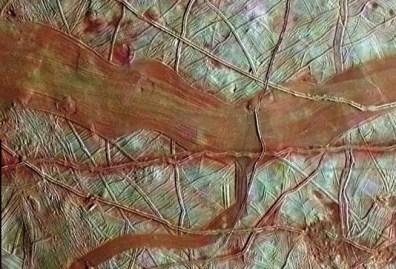 The Jovian moon of Europa remains a mystery that is just dying to be cracked. Although covered in ice, scientists have long understood that tidal forces caused by its proximity to Jupiter have created a warm interior, one which can sustain warm oceans beneath the surface. In the coming years, NASA wants to fly a mission to this planet so we can finally get a look at what, if anything, is lurking beneath that icy crust.
The Jovian moon of Europa remains a mystery that is just dying to be cracked. Although covered in ice, scientists have long understood that tidal forces caused by its proximity to Jupiter have created a warm interior, one which can sustain warm oceans beneath the surface. In the coming years, NASA wants to fly a mission to this planet so we can finally get a look at what, if anything, is lurking beneath that icy crust.
Perhaps emboldened by the success of the Curiosity Rover and the plans for a manned mission to Mars in 2030, NASA has several possible plans for what a Europa mission might look like. If the budget environment proves hospital, then NASA will likely send a satellite that will perform several orbits of the moon, a series of flybys on it, and scout the surface for science and potential landing sites.
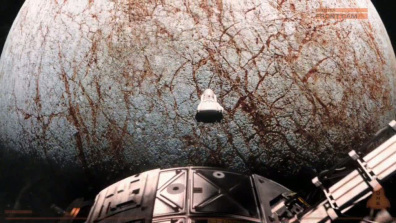 Towards this end, they are looking for proposals for science instruments specifically tailored to the task. And within a year’s time, they plan to select 20 from a list of those proposed for the mission. At which point, the selectees will have $25 million to do a more advanced concept study. As John Grunsfeld, associate administrator for NASA’s science mission directorate, stated:
Towards this end, they are looking for proposals for science instruments specifically tailored to the task. And within a year’s time, they plan to select 20 from a list of those proposed for the mission. At which point, the selectees will have $25 million to do a more advanced concept study. As John Grunsfeld, associate administrator for NASA’s science mission directorate, stated:
The possibility of life on Europa is a motivating force for scientists and engineers around the world. This solicitation will select instruments which may provide a big leap in our search to answer the question: are we alone in the universe?
The Europa mission is not a guarantee, and it’s unclear just how much money will be allocated to it in the long run. NASA has requested $15 million in fiscal 2015 for the mission, but the mission will naturally be subject to budgetary approvals by Congress. If it passes all obstacles, it would fly sometime in the 2020s, according to information released with the budget earlier this year.
 In April, NASA sent out a request for information to interested potential participants on the mission itself, which it plans to cost less than $1 billion (excluding launch costs). Besides its desire to look for landing sites, NASA said the instruments should also be targeted to meet the National Resource Council’s (NRC) Planetary Decadal Survey’s desires for science on Europa.
In April, NASA sent out a request for information to interested potential participants on the mission itself, which it plans to cost less than $1 billion (excluding launch costs). Besides its desire to look for landing sites, NASA said the instruments should also be targeted to meet the National Resource Council’s (NRC) Planetary Decadal Survey’s desires for science on Europa.
In NASA’s words, these are what those objectives are:
Characterize the extent of the ocean and its relation to the deeper interior;
Characterize the ice shell and any subsurface water, including their heterogeneity, and the nature of surface-ice-ocean exchange;
Determine global surface, compositions and chemistry, especially as related to habitability;
Understand the formation of surface features, including sites of recent or current activity, identify and characterize candidate sites for future detailed exploration;
Understand Europa’s space environment and interaction with the magnetosphere.
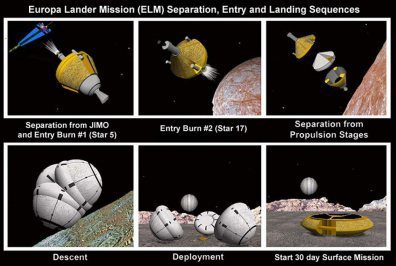 According to the agency, any instrument proposal must meet NASA’s landing scout goal or the NRC goals. The instruments must also be highly protected against the harsh radiation, and meet planetary protection requirements to ensure no extraterrestrial life is contaminated with our own. In essence, this means than any instruments must be safeguarded against carrying bacteria that could play havoc with Europan microbes or (do we dare to dream!) more complex organisms.
According to the agency, any instrument proposal must meet NASA’s landing scout goal or the NRC goals. The instruments must also be highly protected against the harsh radiation, and meet planetary protection requirements to ensure no extraterrestrial life is contaminated with our own. In essence, this means than any instruments must be safeguarded against carrying bacteria that could play havoc with Europan microbes or (do we dare to dream!) more complex organisms.
Solicitations are due by Oct. 17, so if you’ve got an idea and think it might make the cut, consult the following solicitation page and have a look at what NASA is looking for. Personally, I got nothing. But that’s why they don’t pay me the big bucks! No, like most of humanity, I will simply be sitting back and hoping that a mission to Europa happens within my lifetime, and that it uncovers – to quote Arthur C. Clarke’s 201o: Odyssey Two – “something wonderful”…
Source: universetoday.com, nspires.nasaprs.com


July 27, 2014
The 3-D Printing Revolution: 3-D Printed Spinal Cages
 Additive manufacturing has been a boon for many industries, not the least of which is medicine. In the past few years, medical researchers have been able to use the technology to generate custom-made implants for patients, such as skull and jaw implants, or custom-molded mouthpieces for people with sleep apnea. And now, a new type of 3-D printed spine cage has been created that will assist in spinal fusion surgery.
Additive manufacturing has been a boon for many industries, not the least of which is medicine. In the past few years, medical researchers have been able to use the technology to generate custom-made implants for patients, such as skull and jaw implants, or custom-molded mouthpieces for people with sleep apnea. And now, a new type of 3-D printed spine cage has been created that will assist in spinal fusion surgery.
Used as a treatment for conditions such as disc degeneration and spinal instability, spinal fusion surgery is designed to help separate bones grow together into a solid composite structure. This is where the spine cage comes in, by acting as a replacement for deformed and damaged discs, serving to separate the vertebrae, align the spine and relieve spinal nerves from pressure.
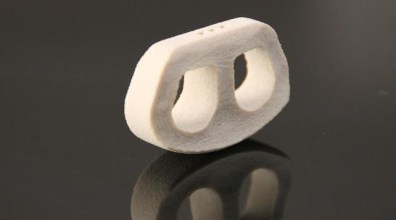 Much like its strength in other areas of medicine, the potential of 3-D printing in spinal fusion surgery lies in the ability to tailor it to the patient’s anatomy. Medicrea, a Paris-based orthopedic implant manufacturer, used custom software and imaging techniques to produce a Polyetherketoneketone (PEKK) spine cage, customized to perfectly fit a particular patient’s vertebral plates.
Much like its strength in other areas of medicine, the potential of 3-D printing in spinal fusion surgery lies in the ability to tailor it to the patient’s anatomy. Medicrea, a Paris-based orthopedic implant manufacturer, used custom software and imaging techniques to produce a Polyetherketoneketone (PEKK) spine cage, customized to perfectly fit a particular patient’s vertebral plates.
The surgery was performed in May, with the surgeon since hailing the procedure a success, due largely to the role of 3D printing.Dr. Vincent Fiere, the surgeon who performed the procedure at Hospital Jean Mermoz in Lyon, France, explained:
The intersomatic cage, specifically printed by Medicrea for my patient, positioned itself automatically in the natural space between the vertebrae and molded ideally with the spine by joining intimately with the end plates, despite their relative asymmetry and irregularity.
 While this particular process is patent-pending, Medicrea is hopeful the breakthrough will pave the way for the development of similar implantable devices that can replace or reinforce damaged parts of the spine. Much like other implants that can be made on site and tailored to needs of individual patient’s, it will also speed up the delivery process for potentially life-saving surgeries.
While this particular process is patent-pending, Medicrea is hopeful the breakthrough will pave the way for the development of similar implantable devices that can replace or reinforce damaged parts of the spine. Much like other implants that can be made on site and tailored to needs of individual patient’s, it will also speed up the delivery process for potentially life-saving surgeries.
C0mbined with the strides being made in the field of biomedicine (where it is used to create tailor-made organic tissues), 3-D printing is helping to usher in a future where medicine is more personalized, accessible and cost-effective.
Source: gizmag.com


July 26, 2014
The Future is Here: Morphable Skins
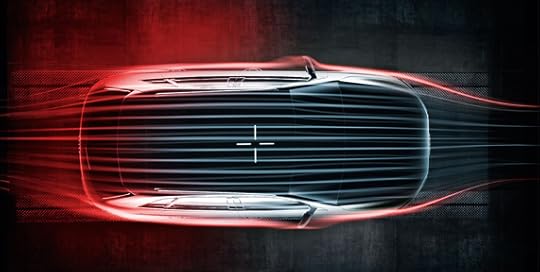 Tomorrow’s cars could have a feature that will reduce wind drag and allow them to go faster: smart, morphing skins that form dimples or go smooth on command. It is all part of a growing field of mechanics that seeks to make surfaces “smart”, and it is being considered for everything from increasing aerodynamics to reducing the damage caused by hurricanes and high winds.
Tomorrow’s cars could have a feature that will reduce wind drag and allow them to go faster: smart, morphing skins that form dimples or go smooth on command. It is all part of a growing field of mechanics that seeks to make surfaces “smart”, and it is being considered for everything from increasing aerodynamics to reducing the damage caused by hurricanes and high winds.
The research comes from MIT, where engineers have developed a smart curved surface that can morph at will to reduce drag. Known as a “smorph” (short for smart morphable surface), they were able to get their creation to wrinkle into a dimpled pattern similar to a golf ball’s, with similar aerodynamic properties. In short, when the smorph wrinkles, it is able to travel faster than if it were smooth.
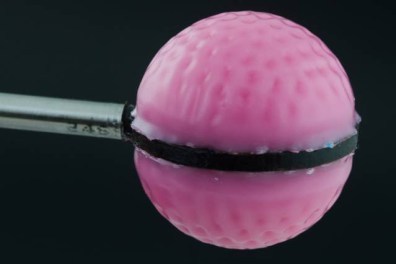 Scientists and golfers alike have long known that the dimples on the surface of a golf ball allow it to drastically reduce drag and travel much farther than would otherwise be possible. This happens because the small dents hold the airflow near the surface of ball for a longer time. This reduces the size of the wake, or zone of turbulence, as the ball takes off. However, the mechanics employed here are a bit more complex.
Scientists and golfers alike have long known that the dimples on the surface of a golf ball allow it to drastically reduce drag and travel much farther than would otherwise be possible. This happens because the small dents hold the airflow near the surface of ball for a longer time. This reduces the size of the wake, or zone of turbulence, as the ball takes off. However, the mechanics employed here are a bit more complex.
In recent years, in-depth aerodynamic studies have shown that the dimples reduce drag only at lower speeds. As you move toward faster speeds, the advantage of irregularities disappears and a smooth surface becomes the best way to minimize the wake. Now, researchers at MIT have married the best of both worlds by developing a surface that can it’s smoothness on the fly to maximize aerodynamic efficiency at all speeds.
 The smorph manages to change its shape by changing the balance between its materials. Basically, an empty core is surrounded by two different polymers. One is thick and squishy, while the outermost layer is stiff skin. As the volume of a the inner layer is reduced by sucking air out of its hollow core, the core shrinks. The squishy layer is soft enough to contract smoothly, but the skin is forced to wrinkle. The trick is controlling exactly how a smorph wrinkles.
The smorph manages to change its shape by changing the balance between its materials. Basically, an empty core is surrounded by two different polymers. One is thick and squishy, while the outermost layer is stiff skin. As the volume of a the inner layer is reduced by sucking air out of its hollow core, the core shrinks. The squishy layer is soft enough to contract smoothly, but the skin is forced to wrinkle. The trick is controlling exactly how a smorph wrinkles.
Because the dimples look so much like those on a golf ball’s surface, the researchers were inspired to test their creation in a wind tunnel. Sure enough, when the researchers tested the smorph in a wind tunnel, they found that it was about twice as aerodynamically efficient when dimpled. But the sheath of vortices only form at relatively low speeds, and then convert back to a smooth surface at higher speeds in order to maintain aerodynamic velocity.
 This is where smorphs could offer a huge advantage. By being able to morph to control drag, they could be especially useful in building structures that won’t collapse or incur significant damage when facing very high winds – one example being the so-called radomes, the spherical, weatherproof domes that enclose radar antennas. The researchers also say that the materials could also be used to minimize drag in cars in order to maximize fuel efficiency.
This is where smorphs could offer a huge advantage. By being able to morph to control drag, they could be especially useful in building structures that won’t collapse or incur significant damage when facing very high winds – one example being the so-called radomes, the spherical, weatherproof domes that enclose radar antennas. The researchers also say that the materials could also be used to minimize drag in cars in order to maximize fuel efficiency.
Earlier this year, Reis won an NSF grant to keep developing smorphs, which he hopes to someday scale up to use on cars, aircraft, and even buildings. There are some issues to overcome before this happens though, such as the fact that hexagonal dimples are unstable on flat surfaces. So far smorphs have only been used on a round, ball shape, but Reis and his co-authors believe they can figure out how to reproduce the pattern on slightly curved surfaces.
Alongside such concepts as morphing wings and self-adjusting and reconfigurable robots, the creation of surfaces that can change shape in order to better accommodate airflow, or be optimal for different tasks, is part of the manufacturing revolution that seeks to replace rigid structures and products with something that can adapt, flow and transform depending on what is being asked of it.
And be sure to check out this video from MIT of the smorph in action:
Sources: wired.com, gizmag.com


July 25, 2014
Climate Crisis: The DOE’s Massive CC Operation
 Until such a time exists that clean, renewable energy can provide sustainable energy for cheaper than gas or coal, we can expect that producing energy will continue to generate a carbon footprint. However, the energy industry has been been touting the benefits of carbon capture and sequestration (CCS), which they claim can make traditionally dirty forms of energy much cleaner.
Until such a time exists that clean, renewable energy can provide sustainable energy for cheaper than gas or coal, we can expect that producing energy will continue to generate a carbon footprint. However, the energy industry has been been touting the benefits of carbon capture and sequestration (CCS), which they claim can make traditionally dirty forms of energy much cleaner.
Thus far, few of the project have worked out as planned. But now, the US Department of Energy has started construction on a CSS project using proven technology that will be the largest system in existence. All the action is happening at a coal-fired power plant near Houston where – with the help of NRG Energy and JX Nippon – the DOE hopes to build a carbon capture system that can put 90% of the CO2 output of coal back into the ground where it can’t affect the climate.
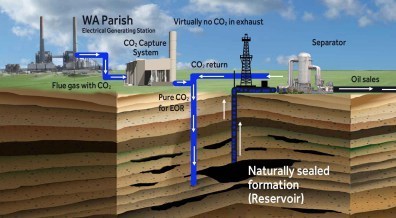 The Petra Nova refit was originally going to be a modest DOE project that would retain 60 megawatts of energy generation, but the extra engineering muscle from NRG Energy and JX Nippon boosted the plan dramatically. Petra Nova will now be built with the intention of capturing the carbon output from 240 megawatts. The whole idea of carbon capture is to get the energy out of fossil fuels like coal and oil without releasing the carbon at the same time.
The Petra Nova refit was originally going to be a modest DOE project that would retain 60 megawatts of energy generation, but the extra engineering muscle from NRG Energy and JX Nippon boosted the plan dramatically. Petra Nova will now be built with the intention of capturing the carbon output from 240 megawatts. The whole idea of carbon capture is to get the energy out of fossil fuels like coal and oil without releasing the carbon at the same time.
By taking carbon out of the ground and putting it in the atmosphere, the overwhelming majority of scientists believe we are causing global temperatures to increase. Putting the carbon back underground removes it from the atmosphere and maintains the environmental balance we currently enjoy. However, carbon sequestration might need to expand beyond new energy production.
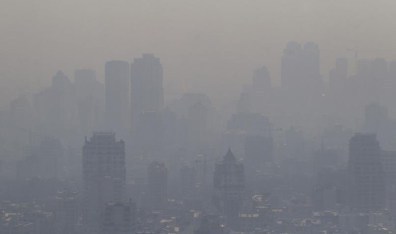 Petra Nova will be using a scaled-up version of smaller amine-based CO2 CC systems. In these, CO2 is routed into a chamber where an amine-based solvent absorbs the gas. The resulting carbon-rich solution isl then sent through another chamber where low pressure steam is used to break the bond holding the carbon in solution so it can be captured while the solvent is reused.
Petra Nova will be using a scaled-up version of smaller amine-based CO2 CC systems. In these, CO2 is routed into a chamber where an amine-based solvent absorbs the gas. The resulting carbon-rich solution isl then sent through another chamber where low pressure steam is used to break the bond holding the carbon in solution so it can be captured while the solvent is reused.
The last step in any CCS system is to get the carbon back underground, but the Petra Nova is doing that in an unusual way. Instead of simply pumping it down in any old place, it will be transmitted via pipeline to the West Ranch oil field about 130 km (80 miles) away. There, it will be used for so-called “enhanced oil recovery”, which means it will be pumped into an oil reservoir deep underground to push previously unreachable oil closer to the surface.
The carbon dioxide does end up underground at the end of the day, but the hydrocarbon fuel cycle keeps on churning with increased oil output from the field. Naturally, the amount of carbon released by oil recovered from the West Ranch oil field will be far greater than what is recovered by this one power plant. Still, the Petra Nova project is a good way to subsidize the development of carbon capture tech until such time as it’s installed in all suitable facilities.
Source: extremetech.com


Climate Crisis: US Dept of Energy’s Massive CC Operation
 Until such a time exists that clean, renewable energy can provide sustainable energy for cheaper than gas or coal, we can expect that producing energy will continue to generate a carbon footprint. However, the energy industry has been been touting the benefits of carbon capture and sequestration (CCS), which they claim can make traditionally dirty forms of energy much cleaner.
Until such a time exists that clean, renewable energy can provide sustainable energy for cheaper than gas or coal, we can expect that producing energy will continue to generate a carbon footprint. However, the energy industry has been been touting the benefits of carbon capture and sequestration (CCS), which they claim can make traditionally dirty forms of energy much cleaner.
Thus far, few of the project have worked out as planned. But now, the US Department of Energy has started construction on a CSS project using proven technology that will be the largest system in existence. All the action is happening at a coal-fired power plant near Houston where – with the help of NRG Energy and JX Nippon – the DOE hopes to build a carbon capture system that can put 90% of the CO2 output of coal back into the ground where it can’t affect the climate.
 The Petra Nova refit was originally going to be a modest DOE project that would retain 60 megawatts of energy generation, but the extra engineering muscle from NRG Energy and JX Nippon boosted the plan dramatically. Petra Nova will now be built with the intention of capturing the carbon output from 240 megawatts. The whole idea of carbon capture is to get the energy out of fossil fuels like coal and oil without releasing the carbon at the same time.
The Petra Nova refit was originally going to be a modest DOE project that would retain 60 megawatts of energy generation, but the extra engineering muscle from NRG Energy and JX Nippon boosted the plan dramatically. Petra Nova will now be built with the intention of capturing the carbon output from 240 megawatts. The whole idea of carbon capture is to get the energy out of fossil fuels like coal and oil without releasing the carbon at the same time.
By taking carbon out of the ground and putting it in the atmosphere, the overwhelming majority of scientists believe we are causing global temperatures to increase. Putting the carbon back underground removes it from the atmosphere and maintains the environmental balance we currently enjoy. However, carbon sequestration might need to expand beyond new energy production.
 Petra Nova will be using a scaled-up version of smaller amine-based CO2 CC systems. In these, CO2 is routed into a chamber where an amine-based solvent absorbs the gas. The resulting carbon-rich solution isl then sent through another chamber where low pressure steam is used to break the bond holding the carbon in solution so it can be captured while the solvent is reused.
Petra Nova will be using a scaled-up version of smaller amine-based CO2 CC systems. In these, CO2 is routed into a chamber where an amine-based solvent absorbs the gas. The resulting carbon-rich solution isl then sent through another chamber where low pressure steam is used to break the bond holding the carbon in solution so it can be captured while the solvent is reused.
The last step in any CCS system is to get the carbon back underground, but the Petra Nova is doing that in an unusual way. Instead of simply pumping it down in any old place, it will be transmitted via pipeline to the West Ranch oil field about 130 km (80 miles) away. There, it will be used for so-called “enhanced oil recovery”, which means it will be pumped into an oil reservoir deep underground to push previously unreachable oil closer to the surface.
The carbon dioxide does end up underground at the end of the day, but the hydrocarbon fuel cycle keeps on churning with increased oil output from the field. Naturally, the amount of carbon released by oil recovered from the West Ranch oil field will be far greater than what is recovered by this one power plant. Still, the Petra Nova project is a good way to subsidize the development of carbon capture tech until such time as it’s installed in all suitable facilities.
Source: extremetech.com


July 24, 2014
Video Goes Viral, Kim Jong Un is Pissed!
 A new video was recently posted online that shows North Korean dictator Kim Jong Un breaking out the dance moves, getting pranked, and engaging in some serious fight scenes. The video has gone absolutely viral and has everybody laughing – except for Kim Jong Un himself. In fact, the “Great Leader’s” outrage was such that North Korea made a public statement denouncing the video and demanding it be taken down.
A new video was recently posted online that shows North Korean dictator Kim Jong Un breaking out the dance moves, getting pranked, and engaging in some serious fight scenes. The video has gone absolutely viral and has everybody laughing – except for Kim Jong Un himself. In fact, the “Great Leader’s” outrage was such that North Korea made a public statement denouncing the video and demanding it be taken down.
According to the English-language Korean newspaper The Chosun Ilbo, the video was made by a Chinese man bearing the surname Zhang who reportedly studied at a university in South Korea. The paper goes on to cite a source in China saying North Korea felt the clip “seriously compromises Kim’s dignity and authority” and asked China to stop the spread of the video, but that “Beijing was unable to oblige.”
 The reaction is predictable, and the request certainly betrays the North Korean regime’s internet-phobic tendencies, not to mention their ignorance of how the internet actually works. For starters, once something is posted on the internet, it becomes part of the digital ether and can never be destroyed. In addition, drawing attention to an internet phenomenon only makes it stronger! By condemning it, Kim Jong Un’s people just ensured it’s viral nature!
The reaction is predictable, and the request certainly betrays the North Korean regime’s internet-phobic tendencies, not to mention their ignorance of how the internet actually works. For starters, once something is posted on the internet, it becomes part of the digital ether and can never be destroyed. In addition, drawing attention to an internet phenomenon only makes it stronger! By condemning it, Kim Jong Un’s people just ensured it’s viral nature!
The video consists of the Dear Leader’s head being spliced onto a variety of bodies that see him getting down on a ball field, getting karate-kicked by Obama (who also has his head spliced onto various heads), skipping through a field with Osama Bin Laden, and doing some serious kung fu fighting. And it all takes place to a Chinese pop hit by the Chopstick Brothers, who have made viral videos of their own in the past.
Needless to say, it’s really quite funny. And it’s only made more so by the fact that the man-child leading the world’s most backward and ridiculous regime finds its so infuriating. So be sure to watch it, enjoy it, and contribute to its circulation!
Source: cnet.com


The Future of Housing: Casa Futebol Concept
 It’s no secret that Brazil’s decision to host the 2014 World Cup was the source of controversy. With roughly $4 billion spent on renovating and constructing the stadiums needed to host the international event, many wondered why that money could not have been spent addressing other infrastructure concerns – such as providing housing and utilities for its many impoverished citizens.
It’s no secret that Brazil’s decision to host the 2014 World Cup was the source of controversy. With roughly $4 billion spent on renovating and constructing the stadiums needed to host the international event, many wondered why that money could not have been spent addressing other infrastructure concerns – such as providing housing and utilities for its many impoverished citizens.
However, drawing inspiration from the social issues plaguing much of the publicity around the event, a pair of French architects have developed a proposal to re-invent the structures as complexes for low-cost housing. While most of the stadiums constructed for the World Cup will continue to host football matches, Brazil’s local teams stand to draw a fraction of the crowds that attended the event, doing little to assuage concerns of wasted resources.
 Other buildings, such as the Arena da Amazonia, face a less certain future. Located in the jungle city of Manaus, the 44,500 seat stadium is perhaps the most contentious of Brazil’s World Cup creations. A local judge proposed converting it into a center for temporary detainees to tackle the city’s overflowing prisons, though this was met with fervent opposition from government officials.
Other buildings, such as the Arena da Amazonia, face a less certain future. Located in the jungle city of Manaus, the 44,500 seat stadium is perhaps the most contentious of Brazil’s World Cup creations. A local judge proposed converting it into a center for temporary detainees to tackle the city’s overflowing prisons, though this was met with fervent opposition from government officials.
The proposal by Axel de Stampa and Sylvain Macaux is perhaps the most ambitious. Dubbed Casa Futebol, it involves transforming each of the 12 World Cup Stadiums into affordable housing for Brazil’s poor and displaced. As Stampa explained in an interview with Gizmag:
The project covers 12 Brazilian stadiums. There are actually six stadiums where we can colonize the exterior facade. Five of these have an exterior structure composed of concrete and metal columns separated by seven or eight meters (23 to 26 ft). We just have to insert pre-fabricated housing using the existing structures.
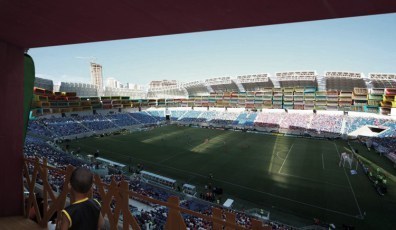 The remaining stadiums would see housing modules that are 105 m2 (1,130 ft2) fitted to the interior at the expense of rows of seating, the only difference between these and those receiving exterior additions being the installation process. Conscious of Brazil’s adoration for the world game, the proposal would see the stadiums altered slightly, but continue to host matches with profits going towards ongoing maintenance and construction of the housing.
The remaining stadiums would see housing modules that are 105 m2 (1,130 ft2) fitted to the interior at the expense of rows of seating, the only difference between these and those receiving exterior additions being the installation process. Conscious of Brazil’s adoration for the world game, the proposal would see the stadiums altered slightly, but continue to host matches with profits going towards ongoing maintenance and construction of the housing.
The project is based on modular pre-fabricated houses. So the only thing that changes is the implantation of the houses… We think that the concept is achievable in all 12 stadiums. You just have to take up some seating and reduce their capacity a little bit.
The team guesses that if converted, the stadiums could each house between 1,500 and 2,000 people per building, and a total of approximately 20,000 across the entire project. This bold proposal for Brazil’s stadiums forms part of a year-long architecture project called 1 week 1 project, where the pair endeavor to produce spontaneous architecture projects every week for one year.
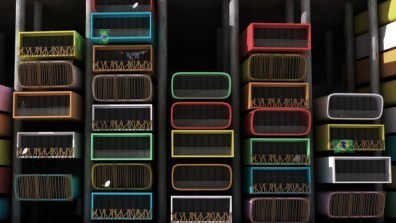 While they don’t have current plans to take the Casa Futebol beyond the concept stage, it is hoped that the project can inspire more socially-conscious approaches to problems of this kind. Combined with 3-D printed housing and other prefab housing projects, this kind of re-purposing of existing infrastructure is a way of addressing the problem of slums, something which goes far beyond the developing world.
While they don’t have current plans to take the Casa Futebol beyond the concept stage, it is hoped that the project can inspire more socially-conscious approaches to problems of this kind. Combined with 3-D printed housing and other prefab housing projects, this kind of re-purposing of existing infrastructure is a way of addressing the problem of slums, something which goes far beyond the developing world.
Source: gizmag.com






